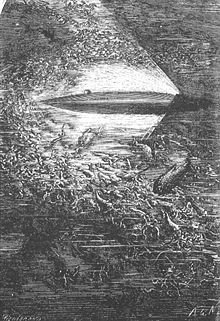The Nautilus, 1800. A subaqueous vessel innovated by Robert Fulton of steamboat fame while he was resident in the French Republic. Fulton reportedly offered it to Napoleon, who declined.
The Nautilus, 1870. Jules Verne’s conceptual improvement on M. Fulton’s invention, mobile palace and fortress of Captain Nemo (a.k.a. Prince Dakkar, vide The Mysterious Island), soi-disant lord of all he surveyed. Impervious to the predations of mammoth cuttlefish, though sadly Nemo’s seamen were not. The eminence of 20,000 Leagues Under the Seas* ensured Verne and the submarine a lasting affiliation.
The Kobukson, 1592. Admiral Yi Soon-Sin of Korea devised and supervised the construction of a warship propelled by oarsmen and caparisoned with metal plates (hence, “turtle ship”).
Candidates for the first of the nine degrees of black belt in the International Taekwon-Do Federation must learn and execute a 30-movement pattern called Choong-Moo (loyalty-chivalry), an honorific conferred on the admiral whose vessel, according to the pattern’s definition, “is said to be the precursor to the present-day submarine.”
From Australopithecus africanus to Homo sapiens. From kobukson to submarine.
Was Verne aware of the kobukson? The answer lies in the speculation of his scholars. Who knows of its existence besides black belts, their instructors and students of Korean military history? Whoever is reading this.
* “Sea” in the original French title is plural.



No Comments